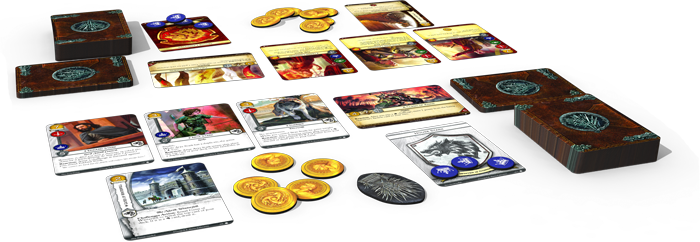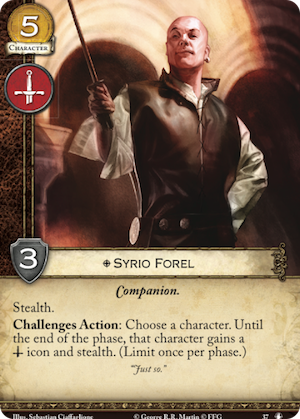“The banners hang limp and sodden, and the men huddle under their cloaks and scarcely speak to one another. Only an evil rain would chill our hearts when most we need them to burn hot.”
–Catelyn Stark, A Storm of Swords
–Catelyn Stark, A Storm of Swords
No matter what deck you play in A Game of Thrones: The Card Game, your choice of agenda is an integral part of your deck. An agenda has ramifications that guide your deckbuilding, your gameplay, or both: defining your deck and your playstyle within the game.
Still, at any given time, some agendas are performing better than others across the stage of the global meta. Today, guest writer James Waumsley takes the time to explore which agendas are performing best right now—and why that might be the case.

James Waumsley on Agendas in A Game of Thrones: The Card Game
As a keen nerd, I like looking at statistics and observing patterns. We’re lucky enough to have access to Alex Hynes’s wonderful Annals of Castle Black, which provides detailed information on the tournament performance of every faction and agenda in A Game of Thrones: The Card Game. A lot of the community’s energy goes into observing and analyzing this data, but while many are quick to point out trends among factions, not so much time is spent looking at agendas. To that end, I want to present a graph of each agenda’s performance since the release of There is My Claim—the “zero hour” for Valar Morghulis (There Is My Claim, 80).
In layman’s terms, this graph depicts chances of a given agenda making the cut, with positive numbers meaning more likely and negative numbers meaning less likely.
Now, Banner of the Kraken is an exception that I’ll explore later, but otherwise every Banner agenda is underperforming and every mono-faction agenda is overperforming. We’re here to analyze some of the reasons why.

Impacting the Game
Non-Banner agendas don’t just change the structure of your deck, they change how the game is played. Fealty (Core Set, 27), Kings of Summer (Called to Arms, 37), and Kings of Winter (Called to Arms, 38) apply economic modifiers to an economy-centric game. The Lord of the Crossing (The King’s Peace, 60) provides challenge manipulation and power gain. "The Rains of Castamere" (Lions of Casterly Rock, 45) lets you manipulate the plot deck during the challenges phase. These are all powerful, game-impacting effects. Meanwhile, the Banner agendas allow you to put twelve or more cards into your deck that you otherwise couldn’t. Those cards have to be pretty amazing or integral to your deck’s vision to make up for your agenda being a non-factor once you draw your opening hand.
Identity Crisis
We’ve established that there has to be an important reason to run a Banner agenda; we need those cards to do something vital—it can’t just be “stuff.” The problem is that many factions have access to similar effects, just in different flavors. Every faction except Baratheon has at least one effect to remove a target character from the board. Every faction either has a way to reduce STR, a way to punish low STR characters, or both. Every faction has draw. Every faction has non-limited economy. Soon, you’re left asking yourself, “What am I bannering for?”


This aspect is further hammered home by the outstanding neutral cards featured in the Core Set. Why banner for stand when you have Seal of the Hand (Core Set, 32)? Why banner for kill when you have Tears of Lys (Core Set, 44) and Put to the Sword (Core Set, 41)? This continues beyond the Core Set too. Syrio Forel (The Road to Winterfell, 37) and Wildling Scout (No Middle Ground, 78) make stealth more common, and you’ll find neutral characters of just about every cost/STR/icon combo, allowing you to fill any hole in your deck. This is compounded by the plot deck, where an array of toolbox effects cover nearly every angle that you may wish to push.
Looking back at the graph, the exception was the faction that primarily escapes this—Greyjoy’s saves and location control significantly outshine their neutral counterparts, offering a banner package worthy of an agenda.
Splitting Factions, Splitting Efficiency

Of course, there’s always the option of just filling your deck with raw efficiency cards. However, in a deckbuilding game like A Game of Thrones: The Card Game, it’s very rare that you can evaluate the power level of a card in a vacuum—there are at least 59 other cards in your deck that the card will interact with. An easy example of this is economy. In a mono-faction deck you have a zero-cost limited location, such as Heart Tree Grove (Core Set, 156), that reduces the cost of the next in-faction card you marshal. Three copies of that card will almost always go in your deck, because it reduces the cost of nearly every card in your deck.
In a banner deck, however, you’ve introduced at least twelve additional cards that will not be reduced by this location. That location isn’t nearly as good as it was, because now your chances of using it every turn are reduced. So do you drop down to two copies of this card, and maybe replace the third copy with an Ocean Road (Lions of Casterly Rock, 42)? Well, now every in-faction card in your deck became less efficient because you’ve lowered your chances of having a location to reduce its cost. This same logic applies to any card that refers to a specific faction— The Wall (Core Set, 137) no longer boosts all your characters, you’re less likely to have a character who enables Treachery (Core Set, 102), Growing Strong (Core Set, 195) is less likely to have three valid targets, and so on.
What this means is that bannering for raw power is generally a poor strategy, because you’re actually weakening the power level of many cards in your deck by the simple act of bannering. When you do choose to build a banner deck, it’s best to look for cards that interact with your deck’s central strategy.
A Young Cardpool
Let’s assume you’ve found a card or two from your chosen banner that are important to your strategy. Great! Now pick the other six to ten cards you need to make the deck legal. Pre-Valar Morghulis, you could at least throw in three copies of the one-cost reducer character, e.g. Garden Caretaker (Core Set, 188), but now that’s a harder step to make. You’re left with picking another handful of cards that are likely worse than your own in-faction options. The agenda is constraining your deckbuilding—the very part of your game that it’s supposed to enhance!
One way to get around this is to take an entire subtheme rather than one card—such as bringing in Melisandre(Core Set, 47) and other R’hllor cards to add a kneel module to your deck. However, this can present a problem when some cards in the subtheme are loyal and some are not. House Targaryen, for example, has the Dothraki subtheme, but Jhogo (True Steel, 113) and Khal Drogo (Core Set, 162) are loyal, preventing it from being fully realized in a Banner of the Dragon deck. In House Lannister, Harrenhal (For Family Honor, 50) and Tower of the Hand (Wolves of the North, 30) aren’t loyal, but Hear Me Roar! (Core Set, 100) and I Never Bet Against My Family (The King’s Peace, 50) are loyal, which keeps “jumpers” as a House Lannister deck rather than Banner of the Lion. It is rare to find enough non-loyal cards for you to reliably use a subtheme in a banner without just feeling like a pale imitation of its main faction counterpart.


This is exacerbated by the current depth of the cardpool—at the start of the game’s life, there weren’t enough cards with raw efficiency to adequately flesh out a mono-faction deck, and cards like Viserion (Core Set, 166) were good options in a banner to round out your deck’s curve. Nowadays, the pool is large enough for mono-faction decks to work, but not yet large enough for fully synergistic subthemes to feature in banner decks.
Now, this isn’t to say that banner decks cannot work. They can, and they have. However, our young game has emerged from childhood, but not yet fully matured. And like many adolescents, it appears to currently be experiencing mono.

Nenhum comentário:
Postar um comentário